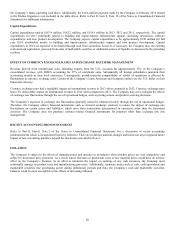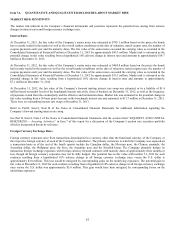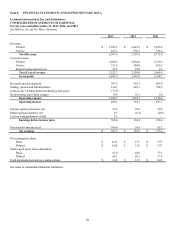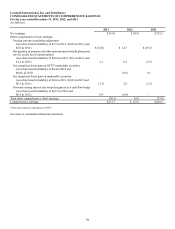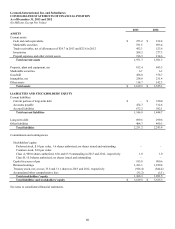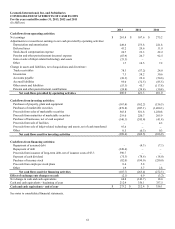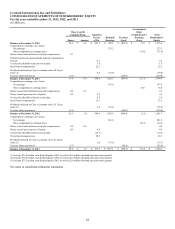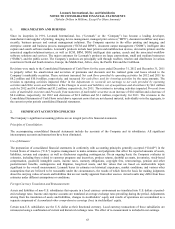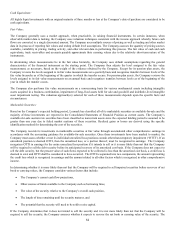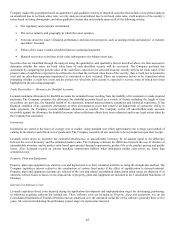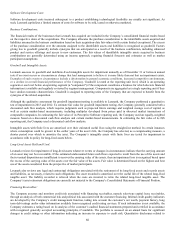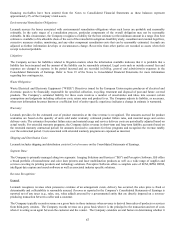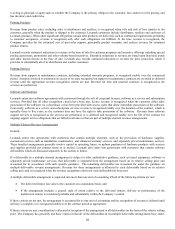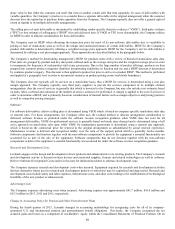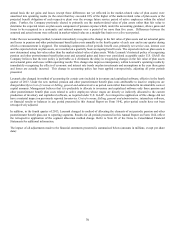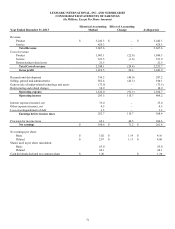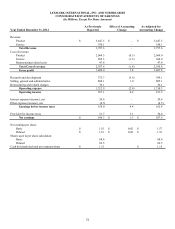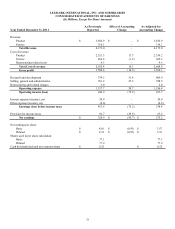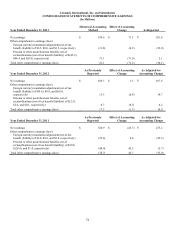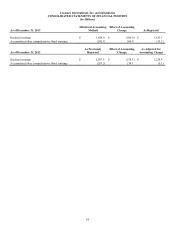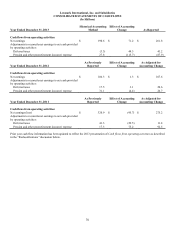Lexmark 2013 Annual Report Download - page 70
Download and view the complete annual report
Please find page 70 of the 2013 Lexmark annual report below. You can navigate through the pages in the report by either clicking on the pages listed below, or by using the keyword search tool below to find specific information within the annual report.
66
Software Development Costs:
Software development costs incurred subsequent to a product establishing technological feasibility are usually not significant. As
such, Lexmark capitalizes a limited amount of costs for software to be sold, leased or otherwise marketed.
Business Combinations:
The financial results of the businesses that Lexmark has acquired are included in the Company’s consolidated financial results based
on the respective dates of the acquisitions. The Company allocates the purchase consideration to the identifiable assets acquired and
liabilities assumed in the business combination based on their acquisition-date fair values (with certain limited exceptions). The excess
of the purchase consideration over the amounts assigned to the identifiable assets and liabilities is recognized as goodwill. Factors
giving rise to goodwill generally include synergies that are anticipated as a result of the business combination, including enhanced
product and service offerings and access to new customers. The fair values of identifiable intangible assets acquired in business
combinations are generally determined using an income approach, requiring financial forecasts and estimates as well as market
participant assumptions.
Goodwill and Intangible Assets:
Lexmark assesses its goodwill and indefinite-lived intangible assets for impairment annually as of December 31 or between annual
tests if an event occurs or circumstances change that lead management to believe it is more likely than not that an impairment exists.
Examples of such events or circumstances include a deterioration in general economic conditions, increased competitive environment,
or a decline in overall financial performance of the Company. Goodwill is tested at the reporting unit level, which is an operating
segment or one level below an operating segment (a "component") if the component constitutes a business for which discrete financial
information is available and regularly reviewed by segment management. Components are aggregated as a single reporting unit if they
have similar economic characteristics. Goodwill is assigned to reporting units of the Company that are expected to benefit from the
synergies of the related acquisition.
Although the qualitative assessment for goodwill impairment testing is available to Lexmark, the Company performed a quantitative
test of impairment in 2013 and 2012. To estimate fair value for goodwill impairment testing, the Company generally considers both a
discounted cash flow analysis, which requires judgments such as projected future earnings and weighted average cost of capital, as
well as certain market-based measurements, including multiples developed from prices paid in observed market transactions of
comparable companies. In estimating the fair value of its Perceptive Software reporting unit, the Company used an equally-weighted
measure based on a discounted cash flow analysis and certain market-based measurements. In estimating the fair value of its ISS
reporting unit, the Company used a discounted cash flow analysis.
Intangible assets with finite lives are amortized over their estimated useful lives using the straight-line method. In certain instances
where consumption could be greater in the earlier years of the asset’s life, the Company has selected, as a compensating measure, a
shorter period over which to amortize the asset. The Company’s intangible assets with finite lives are tested for impairment in
accordance with its policy for long-lived assets below.
Long-Lived Assets Held and Used:
Lexmark reviews for impairment of long-lived assets whenever events or changes in circumstances indicate that the carrying amount
of an asset may not be recoverable. If the estimated undiscounted future cash flows expected to result from the use of the assets and
their eventual disposition are insufficient to recover the carrying value of the assets, then an impairment loss is recognized based upon
the excess of the carrying value of the assets over the fair value of the assets. Fair value is determined based on the highest and best
use of the assets considered from the perspective of market participants.
Lexmark also reviews any legal and contractual obligations associated with the retirement of its long-lived assets and records assets
and liabilities, as necessary, related to such obligations. The asset recorded is amortized over the useful life of the related long-lived
tangible asset. The liability recorded is relieved when the costs are incurred to retire the related long-lived tangible asset. The
Company’s asset retirement obligations are currently not material to the Company’s Consolidated Statements of Financial Position.
Financing Receivables:
The Company assesses and monitors credit risk associated with financing receivables, namely sales-type capital lease receivables,
through an analysis of both commercial risk and political risk associated with the customer financing. Internal credit quality indicators
are developed by the Company’s credit management function, taking into account the customer’s net worth, payment history, long
term debt ratings and/or other information available from recognized credit rating services. If such information is not available, the
Company estimates a rating based on its analysis of the customer’s audited financial statements prepared and certified in accordance
with recognized generally accepted accounting principles, if available. The portfolio is assessed on an annual basis for significant
changes in credit ratings or other information indicating an increase in exposure to credit risk. Quantitative disclosures related to
66


